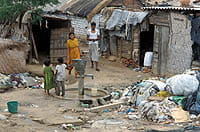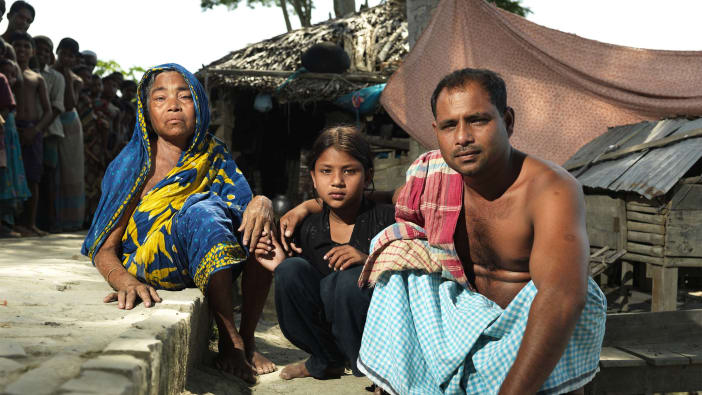
Articles
Reduce, reuse, recycle
We all produce rubbish. Usually we don’t think about it. We just throw it away. But the world is running out of room to store all the rubbish that is piling up
2004 Available in English, French, Spanish and Portuguese

From: Pollution – Footsteps 59
We all have a role to play in reducing the damaging effects of pollution

Photo: Mike Webb/Tearfund
We all produce rubbish. Usually we don’t think about it. We just throw it away. But the world is running out of room to store all the rubbish that is piling up. If left lying around, rubbish becomes a health hazard and looks ugly. Burning rubbish pollutes the air and the ashes are often toxic. Sometimes rubbish is dumped into rivers and lakes and pollutes the water. Often rubbish is buried in the ground. Buried rubbish may contain toxic substances that leak into the soil and pollute the water supply.
There are three things we can do to limit the impact of rubbish on the environment – reduce, reuse and recycle.
Reduce
The best solution is to reduce the rubbish we make in the first place. For example, we should only buy products that do not have much packaging and that we really need.
Think carefully about what kinds of materials are used in the things we buy. Once they become rubbish, they might take a long time to decay.
Plastics There are nearly 50 kinds of plastics commonly used to make everything from juice containers and rubbish bags to windows and doors. Many plastics are strong and durable. They won’t rot, decay or dissolve. However, making plastic uses a lot of energy. Many plastic products cannot be used again, so we throw them out. The problem with plastic rubbish is that it turns into poisonous products. For example, vinyl, which is used to make bottles, car parts and pens, pollutes the soil if it is buried and releases poisonous substances into the air if it is burned. We should try to reduce the amount of plastics that we use. However, some plastics can be recycled to make hair combs, floor tiles and polyester clothing.
Reuse
People are often very imaginative in reusing items, rather than throwing them away. For example, we can flatten empty aluminium cans and use them as sheet metal. We can make furniture out of scrap wood and use well-washed glass jars to store foods, carpentry and office supplies. More examples are given on pages 8–9 in this issue of Footsteps.
Recycle
If items such as glass bottles, metal and tin cans, newspapers and plastics cannot be reused, it may be possible for them to be recycled. For example, glass is washed in special factories, broken into pieces and then melted down into ‘new’ glass ready to be made into something else. Some countries have factories that will recycle these materials.
How long does it take for rubbish to decay?
Newspaper a few weeks
Leather shoes up to 50 years
Cardboard boxes several months
Thin plastic up to 5 years
Banana leaves a few weeks
Tyres unknown
Plastic bags 10–20 years or even hundreds of years, depending on the type of plastic
Scrap metals up to 50 years
Aluminium cans up to 80 years
Plastic bottles hundreds of years
Glass fragments thousands of years
Hazardous waste
Some kinds of rubbish are more dangerous than others. Dangerous rubbish is called hazardous waste. This includes chemical rubbish such as batteries, floor cleaning liquid and insecticides. Medical waste, such as needles, syringes, old medicines and soiled bandages can also be very dangerous. Hazardous waste can seriously damage the environment and our health.
Toxic waste Some hazardous waste is poisonous. If touched, this kind of waste can get into the body and cause cancer or other diseases. It can seriously harm unborn babies. It can also get into the air, water and soil, and kill fish and animals. Poisonous waste comes from such things as cleaning products, rat poison and pesticides. This type of waste usually has a picture of a skull on the container. Corrosive waste Some hazardous waste dissolves almost anything it touches, even human flesh.
Corrosive waste comes from such things as batteries, drain and oven cleaners, and ammonia-based cleaners. It usually has a picture of a skeleton hand on the container.
Flammable waste Some hazardous waste can catch fire and release toxic fumes into the air. Examples are gasoline, oils and paint cleaners. Flammable waste usually has a picture of fire on the container.
Explosive waste Some hazardous waste can blow up when it is mixed with other chemicals or if it is dropped on the ground. Explosive chemicals are found in spray cans, gasoline and lighter fluid. Explosive waste usually has a picture of a bursting ball on the container.
If a container has any of these pictures on it, handle it very carefully. It once contained dangerous material and might still have some waste in it. Never burn these containers because the heat will release poisonous gases and smoke into the air. Be aware that often containers have no warning signs on them.
Governments around the world are slowly forcing industries to make waste less hazardous. In the meantime, we can do our part to handle hazardous waste properly. Never pour toxic liquid, such as used motor oil, paint and pesticides into rivers or lakes or down the sink. Store them separately and find the nearest site that will take them and get rid of them safely. This is very important for our health and for the health of the environment.
Adapted from Developing Countries Farm Radio network – Package 43, Script 4, Jan 1997 and Package 50, Script 10, Nov 1998

Similarly Tagged Content
Share this resource
If you found this resource useful, please share it with others so they can benefit too.

Subscribe to Footsteps magazine
A free digital and print magazine for community development workers. Covering a diverse range of topics, it is published three times a year.
Sign up now - Subscribe to Footsteps magazine





